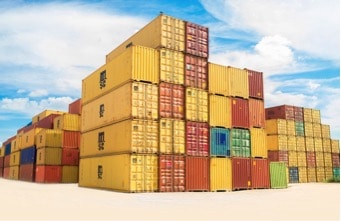2023 Freight Rates, Likely Below Pre-Pandemic Pricing, Great for Importers
2022 is just days away from being over, so it’s time to look forward to 2023. We’ll probably have a few posts focused on what the year will have in store for international shipping, but today we focus on 2023 freight rates. And the outlook is positive for shippers.
Freight Rates Back to or Below Pre-Covid Levels
2023 should not only see freight rates back to pre-Covid levels, but will likely see international shipping pricing below 2019 levels.

This is an easy prediction to make as freight rates are already near 2019 levels and have even fallen below those levels with some Asia to West Coast spot rates. Most industry experts seem to agree things won’t bottom out until well into 2023 when it comes to falling cargo volumes and freight rates, which should have shippers encouraged when it comes to what they’ll be paying to import goods in the new year.
Current Low Asia-West Coast Freight Rates
In an American Shipper article, Greg Miller reports on Asia to West Coast ports:
The Freightos Baltic Daily Index (FBX) assessed China-West Coast rates at $1,378 per forty-foot equivalent unit on Monday. The index has been relatively unchanged since Nov. 23 and is down 93% from its all-time high in September 2021.
It has now done a full round trip since the beginning of the COVID-induced consumer boom — it’s back where it was at this time of year in 2019.
…
Container shipping spot rates are also assessed by Platts, a division of S&P Global Commodities. Platts put North Asia-West Coast spot rates at $1,300 per FEU as of Monday, $50 per FEU below its assessment at this time in 2019.
Current Asia-East Coast Rates
When it comes to Asia to East Coast routes, Miller reports:
FBX put China-East Coast spot rates at $2,905 per FEU on Monday, down 87% from the peak in September 2021, albeit still up $295 per FEU or 11% from pre-COVID levels. Unlike FBX’s West Coast index, which plateaued this month, the FBX East Coast index has slid 16% since Dec. 1.
…
The Drewry WCI Shanghai-New York index was at $3,889 on Thursday, down 76% from the all-time high in September 2021. According to the WCI, spot rates in this lane are still $1,391 per FEU or 56% above where they were at this time in 2019.
What Held Asia-East Coast Rates Year-on-Year Higher Than West Coast Rates
Asia to East Coast rates would likely be at or possibly just below 2019 levels if not for all the cargo that’s been diverted from West Coast ports to East Coast ports in order to avoid labor slowdowns because of the International Longshore & Warehouse Union (ILWU) contract negotiations.
It’s likely the Asia to West Coast rates would be a little bit higher right now if not for the ILWU contract negotiations causing cargo diversion, and I doubt Asia to East Coast freight rates would be all the way at or under 2019 rates, but both would be close and moving in that downward direction because of falling demand.
What’s Dropping Freight Rates
Summer of last year, I was predicting big drops in ocean freight rates in 2022 (and possibly starting earlier) largely because of out-of-control inflation from government overspending and printing of money while consumer expendable cash and government stimuli were running dry. Meanwhile, industry experts were still expecting another great year for carriers in 2022, with continued high freight rates, even if some saw a fairly significant drop in them happening at some point during the year.
I actually thought bad government policies in response to the pandemic would catch up to us sooner than they did. But when inflation finally did hit, it hit hard. And now, economic downturn plummeted shipping demand, having at least the one positive result of falling freight rates. But there are a couple other benefits for shippers, which we’ll mention at the end.
There was also a great deal of investment made by carriers in capacity that would put some downward pressure on freight rates in 2022. Carrier alliances mitigated that some with blanked (cancelled) sailings this year. However, unlike at the beginning of the pandemic, carriers weren’t able to blank enough sailings to make capacity fall under market demand and stop freight rates from dropping. There’s more capacity injection set to put downward pressure in the major trade lanes to the U.S. that are still well above pre-pandemic levels.
Transatlantic Importing Still Triple Pre-Pandemic Freight Rates But Set to Fall
Miller reports transatlantic to the U.S. to be nearly triple what they were in 2019:
The FBX Europe-East Coast assessment was at $5,693 per FEU as of Monday, 2.9 times its level at this time in 2019. The latest Drewry WCI Rotterdam-New York assessment was $6,989 per FEU, also 2.9 times pre-pandemic levels.
Miller quickly got into the increase of capacity poised to hit these trade lanes:
[Sea-Intelligence CEO Alan Murphy] explained, “From mid-December 2022, operated capacity on North Europe-North America East Coast will shift from being roughly at the same level as in 2019 to being 20% higher. And as we get into mid-February 2023, this is poised to jump even further, to 30% [higher]. Capacity from the Mediterranean will grow at an average of 25% over 2019 in January-February 2023.”
Combining this increase of capacity with the economic downturn, these trade lanes that are still boasting freight rates high above pre-pandemic are poised to tumble.
Other Benefits of Reduced Shipping Demand for Importers
It’s true that consumer projections and an uncertain economic picture has retailers who import goods pulling back on those shipments. However, just because there are negative factors at play doesn’t mean there aren’t positives for shippers to look at.
Beyond reduced freight rates, reduced demand is helping clear port congestion and increase shipment reliability, which has been a major problem over the last few years. West Coast ports are as clear of congestion as they’ve been since the pandemic hit.
With the ILWU contract negotiations looking likely to drag on for months, reduced cargo will help mitigate congestion created by labor slowdowns that has unfortunately become a regular part of the negotiation process over the last couple decades.
Ships not getting stuck at anchor outside of ports also brings cargo arrivals more consistently on schedule. There will be (and have been) plenty of blank sailings from carriers to fight overcapacity in attempts to keep freight rates as high as possible, but overall reliability is still improving with reduced demand.
Ultimately, if your business is successful within its niche, 2023 could be a good year for you with favorable shipping conditions despite an economy that has many less than optimistic. Happy New Year to you, yours, and your business from all of us here at Universal Cargo!




